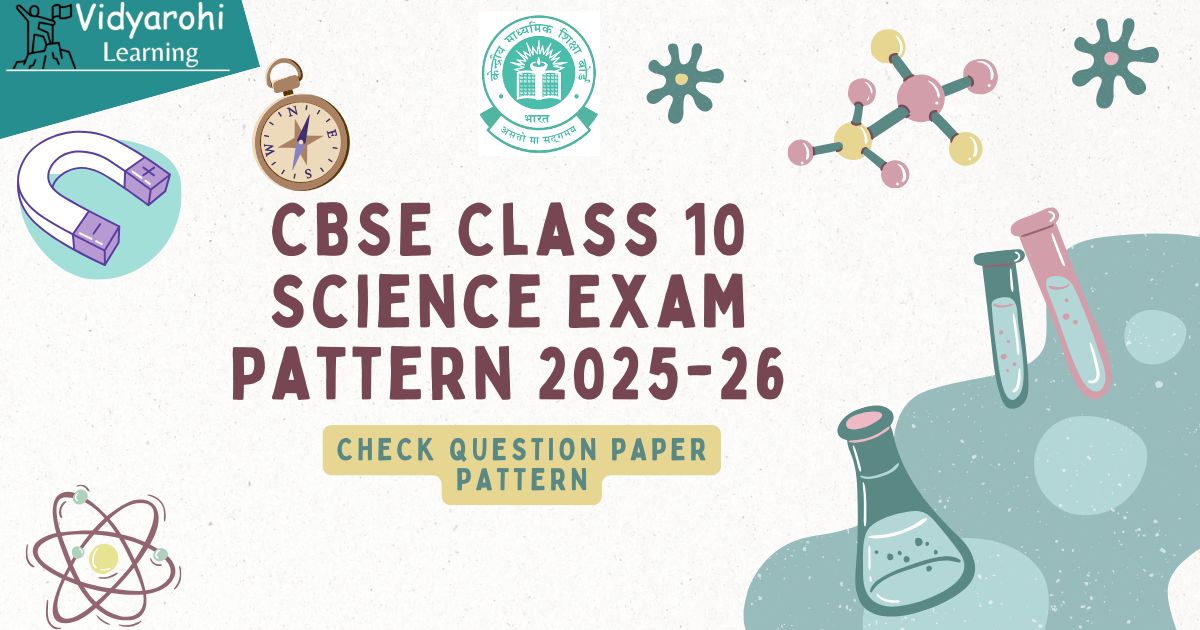CBSE Class 10 Science Exam Pattern 2025: The CBSE Class 10 Science Exam Pattern helps students clearly understand the question paper format, types of questions, and marking scheme. Knowing the exam pattern helps students plan their preparation in a smart way. They can understand which section carries more weightage, practice according to the marks distribution, and improve their time management during the exam. For the 2025-26 academic year, the Central Board of Secondary Education (CBSE) has confirmed that the Science exam pattern and marking scheme will be the same as in 2024-25. This means the exam paper will include a mix of very short, short, and long-answer questions as well as competency-based and application-based questions to test conceptual understanding. In this article, we have explained the complete CBSE Class 10 Science Exam Pattern 2026 in simple terms. You will find details about the question paper format, section-wise weightage, marks distribution, and the marking scheme so you can plan your studies effectively and score higher in the board exam.
CBSE Class 10 Science Question Paper Design 2025-26
CBSE has officially released the Class 10 Science question paper design for the 2025–26 academic year along with the syllabus PDF. For the CBSE Class 10 Science exam, the 2025-26 paper places more emphasis on understanding and applying concepts compared to 2024-25. The weightage for “Demonstrate Knowledge and Understanding” has increased from about 46% to 50%, while “Application of Knowledge/Concepts” has gone up from 22% to 30%. However, the weightage for higher-order skills- “Formulate, Analyse, Evaluate and Create”- has been reduced from 32% to 20%. This shift shows that CBSE now prioritises conceptual clarity and practical application of knowledge over complex analytical tasks in the 2025-26 exam. The internal choice rule remains unchanged; there will be no overall choice in the question paper, but about 33% internal choices will be provided within all sections, just like the previous year's pattern. The following table shows the question paper design for years 2024-25 and 2025-26, including competencies, total marks and weightage percentage.
|
S. No. |
Competencies |
2024-25 | 2025-26 | ||
| Total Marks | % Weightage | Total Marks | % Weightage | ||
| 1 | Demonstrate Knowledge and Understanding | 36-37 | 46% | 40 | 50% |
| 2 | Application of Knowledge/Concepts | 17-18 | 22% | 24 | 30% |
| 3 | Formulate, Analyse, Evaluate and Create | 25-26 | 32% | 16 | 20% |
| Total | 80 | 100% | 80 | 100% | |
CBSE Class 10 Science Exam 2026: Overview
The CBSE Class 10 Science Exam 2025-26 is a key milestone in every student’s academic journey. Science not only carries major weightage in the board exam but also builds the foundation for higher studies in areas like engineering, medicine, data science, and research. The paper covers a broad range of topics from units such as Chemical Substances – Nature and Behaviour, World of Living, Natural Phenomena, Effects of Current, and Natural Resources. Understanding the exam pattern, syllabus, and marking scheme beforehand helps students prepare strategically, manage their time, and improve their scores. Below is an overview of the CBSE Class 10 Science Exam 2025-26 presented in a simple table for quick reference.
| Conducting Body | CBSE |
| Mode of Exam | Pen and Paper (Offline) |
| Duration | 3 hours |
| Marks | 80 |
| Total Number of Questions | 39 |
| Section | 3
|
| Question Type |
|
CBSE Class 10 Science Paper Format 2025
The CBSE Class 10 Science question paper has a total of 39 questions divided into three sections – Section A (Biology), Section B (Chemistry) and Section C (Physics). Biology carries the highest weightage of 30 marks, while Chemistry and Physics carry 25 marks each. All questions are compulsory, but some internal choices are provided within the sections. The detailed CBSE Class 10 Science Board Exam Pattern is given below.
| Section | Marks/Qs | Number of Ques | Marks | Type of Ques | Internal Choice |
|
Section A |
1 | 9 | 9 | MCQs, A&R | 0 |
| 2 | 3 | 6 | VSA | 1 | |
| 3 | 2 | 6 | SA | 0 | |
| 4 | 1 | 4 | Case Study-based | In one Subpart | |
| 5 | 1 | 5 | LA | 1 | |
|
Section B |
1 | 8 | 8 | MCQs, A&R | 0 |
| 2 | 1 | 2 | VSA | 0 | |
| 3 | 2 | 6 | SA | 1 | |
| 4 | 1 | 4 | Case Study-based | In one Subpart | |
| 5 | 1 | 5 | LA | 1 | |
|
Section C |
1 | 3 | 3 | MCQs, A&R | 0 |
| 2 | 2 | 4 | VSA | 1 | |
| 3 | 3 | 9 | SA | 0 | |
| 4 | 1 | 4 | Case Study-based | In one Subpart | |
| 5 | 1 | 5 | LA | 1 |
CBSE 12th Science Marking Scheme
The CBSE Class 10 Science Board Exam Marking Scheme ensures a fair evaluation by incorporating stepwise marking for problem-solving questions. Below is the detailed section-wise marking distribution.
- Section A- 16 questions of 30 marks
- Section B- 13 questions of 25 marks
- Section C- 10 questions of 25 marks
However, the marks-wise question distribution is provided below:
- 1 Mark (MCQs, A&R) - 20 questions of 20 marks
- 2 Marks (VSA) - 6 questions of 12 marks
- 3 Marks (SA) - 7 questions of 21 marks
- 4 Marks (Case Study-based) - 3 questions of 12 marks
- 5 Marks (LA) - 3 questions of 15 marks
Expert Tips to Prepare for CBSE Class 10 Science Board Exam 2026
Preparing for the CBSE Class 10 Science Board Exam 2026 requires a smart strategy along with consistent practice. Science is a subject where clarity of concepts, accuracy, and speed play a major role in scoring well. Many students often feel stressed about lengthy problems and tricky case study questions, but with the right approach, it can become one of the most scoring subjects. Below, we are sharing the expert tips that will help you plan your preparation effectively, focus on important topics, manage time wisely, and build the confidence needed to excel in the exam.
- First of all, understand the syllabus and focus on high-weightage chapters.
- Practice previous year question papers and identify frequently asked questions.
- CBSE follows a step-marking pattern, so focus on writing solutions step by step.
- Allocate specific time for each section during practice.
- Solve past years' board papers within 3 hours to improve speed and accuracy.
- NCERT is the key resource for conceptual clarity so revise it thoroughly.
CBSE Class 10 Science Syllabus 2025-26
The Central Board of Secondary Education (CBSE) has released the Science Syllabus for Class 10 for the 2025-26 academic year. This Science Syllabus outlines the course structure, chapters, and topics that students will need to study in the subject. The CBSE Class 10 Science syllabus covers a wide range of topics, including Chemical Substances- Nature and Behaviour, World of Living, Natural Phenomena, Effects of Current, and Natural Resources. It is divided into units with specific weightage, helping students plan their preparation effectively. The Class 10th Science unite-wise chapters and weightage are provided below :
| Unit Name | Chapter Name |
Weightage in Marks |
|
Chemical Substances-Nature and Behaviour |
Chemical Reactions and Equations |
25 |
| Acids, Bases and Salts | ||
| Metals and Non-metals | ||
|
World of Living |
Life processes |
25 |
| Control and coordination in animals and plants | ||
| Reproduction | ||
| Heredity and Evolution | ||
| Natural Phenomena | Natural Phenomena | 12 |
|
How Things Work |
Effects of Current |
13 |
| Magnetic effects of current | ||
| Natural Resources | Our environment | 5 |
| Total | 80 | |


